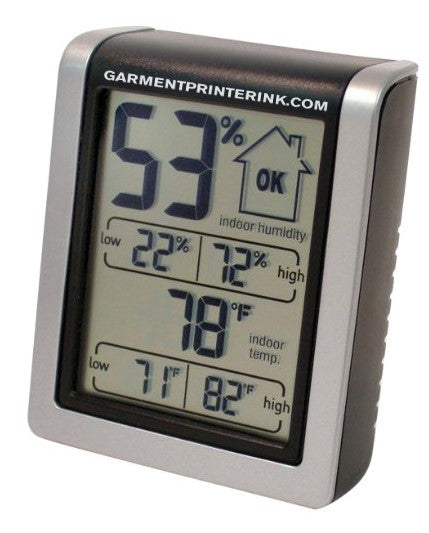Keeping your garment printer warm and humid
If you live in a part of the United States where it gets cold and snows, a warm and comfy home is a nice place to be. You need to take that same stance with your DTG printer, but keeping it warm is just one part of the successful equation.
When the gas furnace kicks on in the winter, the humidity levels quickly drop in our homes and places of business. Natural gas has a tendency to really dry the air out. It doesn’t take long for the humidity levels to quickly drop to what is commonly found in the Southwest most of the year.
Humidity levels below 35% can really start to cause problems with your DTG machine. Get into the 20% and lower and you’re asking for some serious printer issues. It really doesn’t take much to help keep you and your DTG printer happy during these dry, winter months.
First you will want to pick up a temperature/humidity gauge. This one is relatively inexpensive and help give you the tools to know what is going on with your DTG printing room. This shows the temperature and humidity levels. It's absolutely crucial you have one in the room where your DTG is located
If you are not sure what humidity level you should keep in your printing room, ask your DTG manufacturer. Most will give a level range of say 35%-80% humidity. Typically, you can help ensure a safe humidity level if you try to keep it around 50% humidity. This will not only keep your DTG printer happy, but the more humidity – the warmer it will feel in the room. Unless you have a humidifier located on your furnace, you’ll have to utilize a whole room stand alone humidifier. You can find these at your local home depot type store or on Amazon.
Look around but plan on spending around $100 or more.The temperature should also be stabilized. This is where a climate control system comes into play. You don’t want to have your DTG room hover in the 50’s over night and then you try to come in early in the morning and turn the heat on to start a day of printing. The ink in the printer and lines will end up being much cooler and take longer to warm up than the ambient temperature in your printing area. Cooler ink will be less likely to flow as nicely as warm ink and can result in lost nozzles and bad prints. The best thing is to try to maintain a constant temperature when you know you’ll be printing or a range of comfortable room temperatures over the winter.
Use common sense – don’t go from the low 50’s when you’re not there to low 70’s early Monday morning and try to start printing immediately. If you keep it a constant temperature, you know you’ll always be ready to print.Keeping an eye on the temperature and humidity levels and making sure they are within recommended levels will take one variable out of the DTG printing mix this winter. This will enable you to focus on what you really need to be doing – printing and making money.

